Tune-O-Matic and Wraparound bridges are two of the most popular types of bridges for electric guitars. They’ve both been around for decades (having been introduced in the 1950’s) and are well known for being the choice of bridge for Gibson Les Paul’s.
But what’s the difference between them? And is one better than the other? Or better suited for certain types of music?
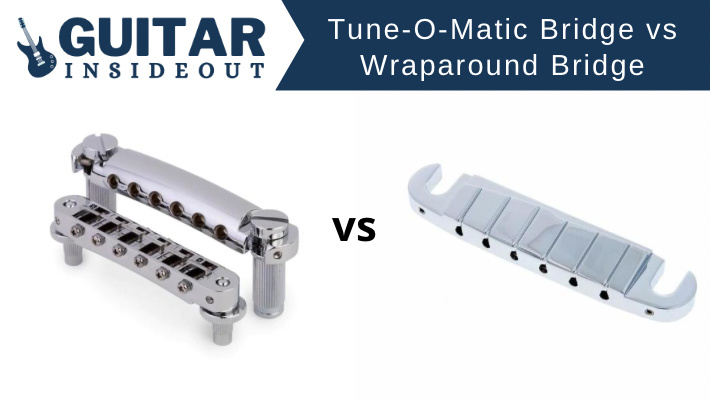
Well let’s take a look at them both and see how they compare, go through the advantages and disadvantages and whether one is right for you.
Main Differences Between Tune-O-Matic Bridges and Wraparound Bridges
The main differences between a Tune-O-Matic Bridge and Wraparound bridge are:
- Tune-O-Matic bridges have two components: a metal bridge and tailpiece. A wraparound bridge has a single piece of metal that serves as both the bridge and tailpiece.
- Tune-O-Matic bridges have individual string saddles for each string which allows you to make more precise adjustments to the intonation. A wraparound bridge however has either limited or no ability to adjust the saddles individually which makes setting the intonation accurately more difficult.
- As Wraparound bridges are a single unit they have greater sustain than the Tune-O-Matic bridge and it’s separate tailpiece. The single unit Wraparound bridge means greater transfer of the vibrations from the strings to the guitar body which increases the sustain.
- The Wraparound design makes restringing the guitar a little easier than the Tune-O-Matic, although both of them are much simpler than a floating tremolo bridge.
- Tune-O-Matic’s are mostly associated with Gibson Les Paul’s and similar style guitars whereas Wraparound bridges are often found on vintage-style guitars or those aiming for a retro look.
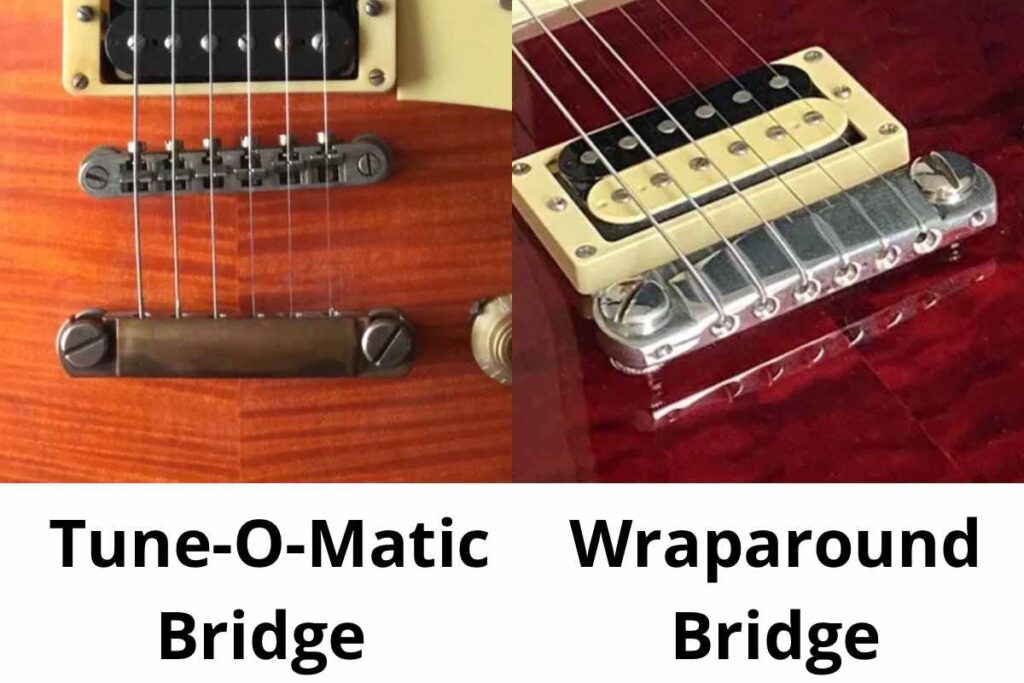
Looking at each bridge and it’s specific characteristics further:
Tune-O-Matic Bridges
- A Tune-O-Matic bridge consists of two main components: a metal bridge and separate tailpiece.
- It has six adjustable saddles and the strings pass over the saddles and are held in place by the tailpiece.
- The individual string saddles for each string allowing you to make very precise adjustments to the intonation.
- Restringing is relatively simple due to the design.
- String height can’t be adjusted individually. The entire bridge has to be raised or lowered.
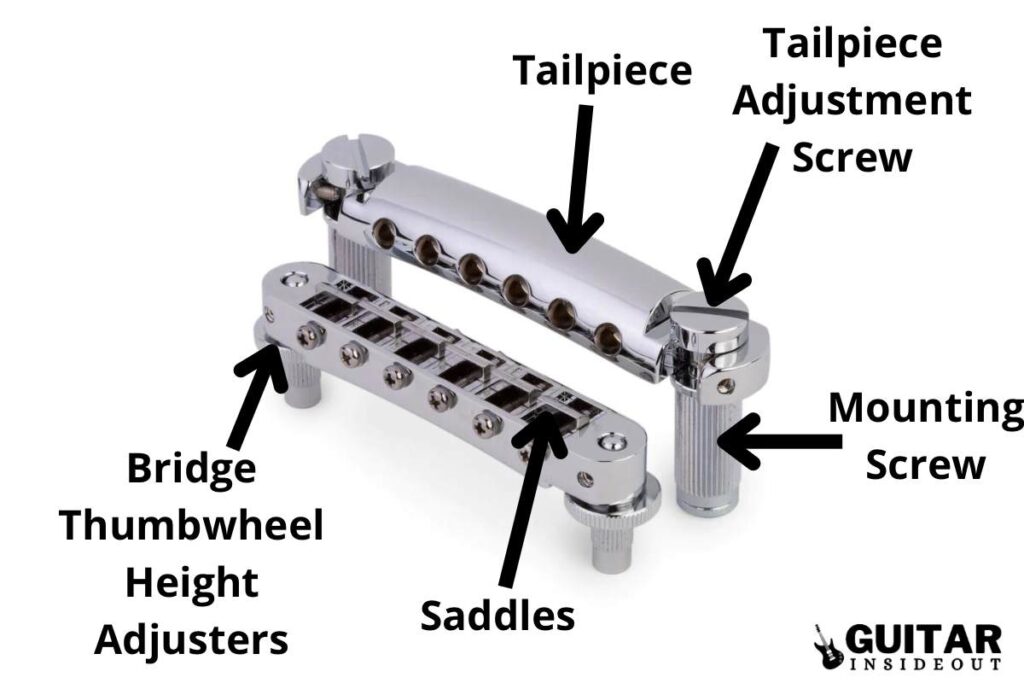
Wraparound Bridges
- Features a single piece of metal that serves as both the bridge and tailpiece.
- Typically has a curved shape with the strings wrapping around it.
- It’s design and single unit provides greater sustain as there is more direct transfer of string vibration to the body of the guitar.
- Doesn’t let you adjust saddles individually so intonation is more difficult to set precisely.
- Action can’t be adjusted individually at each string. The whole bridge has to be moved up and down at one side or the other.
- Simple design makes changing strings easy.
If you’re interested in looking at both bridges in more detail including how they work, what they’re bet for and choosing which is right for you, keep reading.
What is a Tune-O-Matic Bridge?
A Tune-O-Matic bridge (often shortened to T-O-M) is a type of guitar bridge mostly found on electric guitars (although there are a few acoustics that use them too). It was designed and introduced in the 1960’s by Gibson and used on many of their most well known guitars. It has since become very popular on other guitars too.
Advantages of a Tune-O-Matic Bridge
- Tuning Stability: Tune-O-Matic bridges have excellent tuning stability. The tailpiece provides a greater angle for the strings to break over which helps to provide a solid connection between the strings and the guitar body. This in turn reduces string slippage and improves tuning stability.
- Simple Setup: Tune-O-Matic bridges are one of the easier bridge types to use and maintain. You can change strings simply and the adjustments to the intonation are easy. Beginners will need some time to get used to them but that would be the same with any type of bridge if you’re completely new. And Tune-O-Matic’s are definitely easier to use and setup than floating bridges.
- Can be more expensive than some other types of bridges.
Disadvantages of a Tune-O-Matic Bridge
- Action: one of the drawbacks of a Tune-O-Matic is the inability to make individual adjustments to each string height. Instead you have to use one of the two string posts at the bridge to move the entire unit up or down.
- Technique Limitations: if you want to use a tremolo arm/whammy bar then Tune-O-Matic bridges don’t have that ability. So if you want to experiment with vibrato effects or techniques like dive bombs you will need a floating bridge.
- Comfort: not everyone finds Tune-O-Matic bridges comfortable. This can be especially true when resting your hand or wrist on the bridge or palm muting.
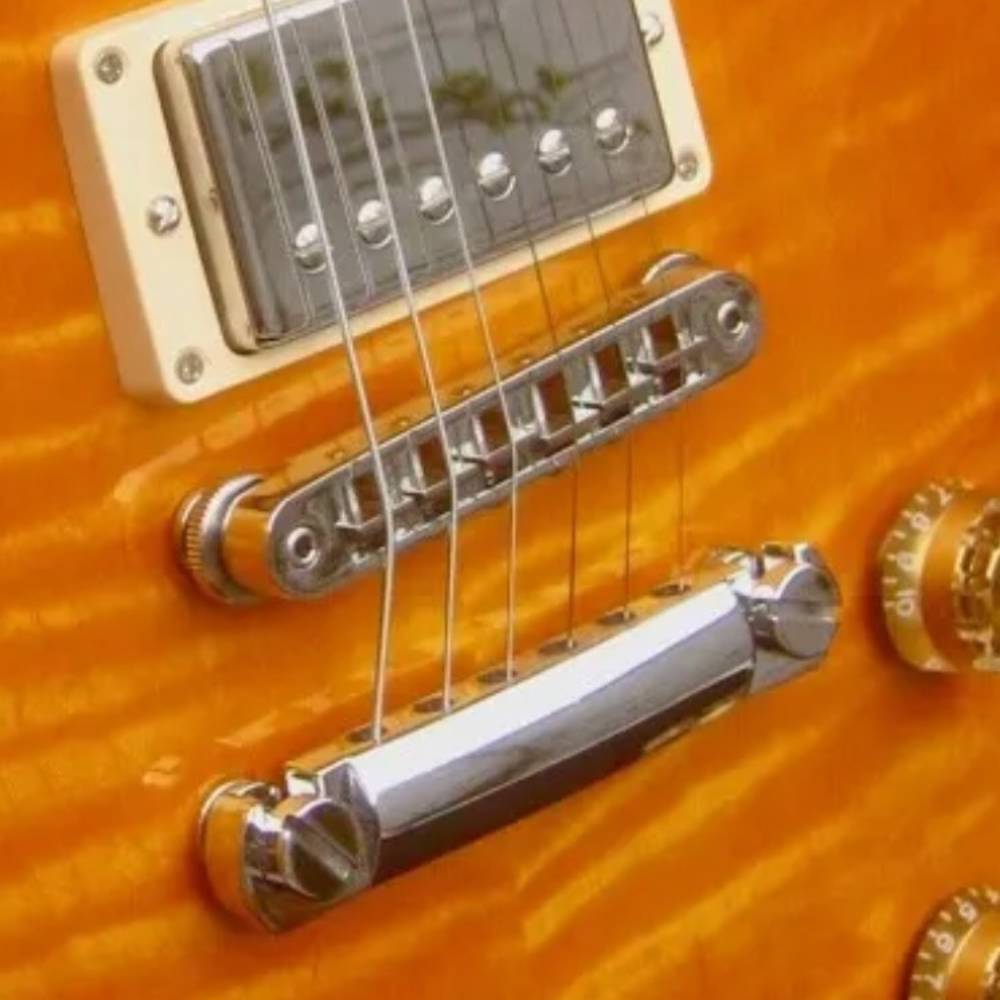
What is a Wraparound Bridge?
A Wraparound bridge is a simple type of electric guitar bridge. Wraparound bridges consist of a single piece of metal that is a combination of the tailpiece and bridge. The strings are threaded through the bridge one-piece and then wrapped around the tailpiece part which anchors them to the guitar’s body.
Advantages of a Wraparound Bridge
- Increased Sustain: as Wraparound bridges are anchored to the body of the guitar in only two places, far less than other types of bridges, they lose far less of the string vibrations. This results in a much greater amount of sustain.
- Simplicity: the one piece design of Wraparound bridges makes them very easy to use. Restringing is simple for beginners as all you have to do is thread the string through and wrap it around the bridge. The simplicity is why Wraparound bridges were originally used on entry level models of Gibson guitars.
- Comfort: depending on your preference a Wraparound can be more comfortable because of the single unit design.
- Generally more affordable compared to Tune-o-Matic bridges.
Disadvantages of a Wraparound Bridge
- Intonation Limitations: Limited or no individual saddle adjustments which affects how much control you have over the setting of the intonation.
- Action: the fixed string height of a wraparound bridge makes it harder to adjust string height for each string individually. Instead it requires you to adjust the height of the entire bridge to achieve the desired action.
- Tuning Stability: while generally Wraparound bridges are stable when it comes to tuning the string break angle over the bridge can sometimes cause tuning stability issues, especially with heavier gauge strings.
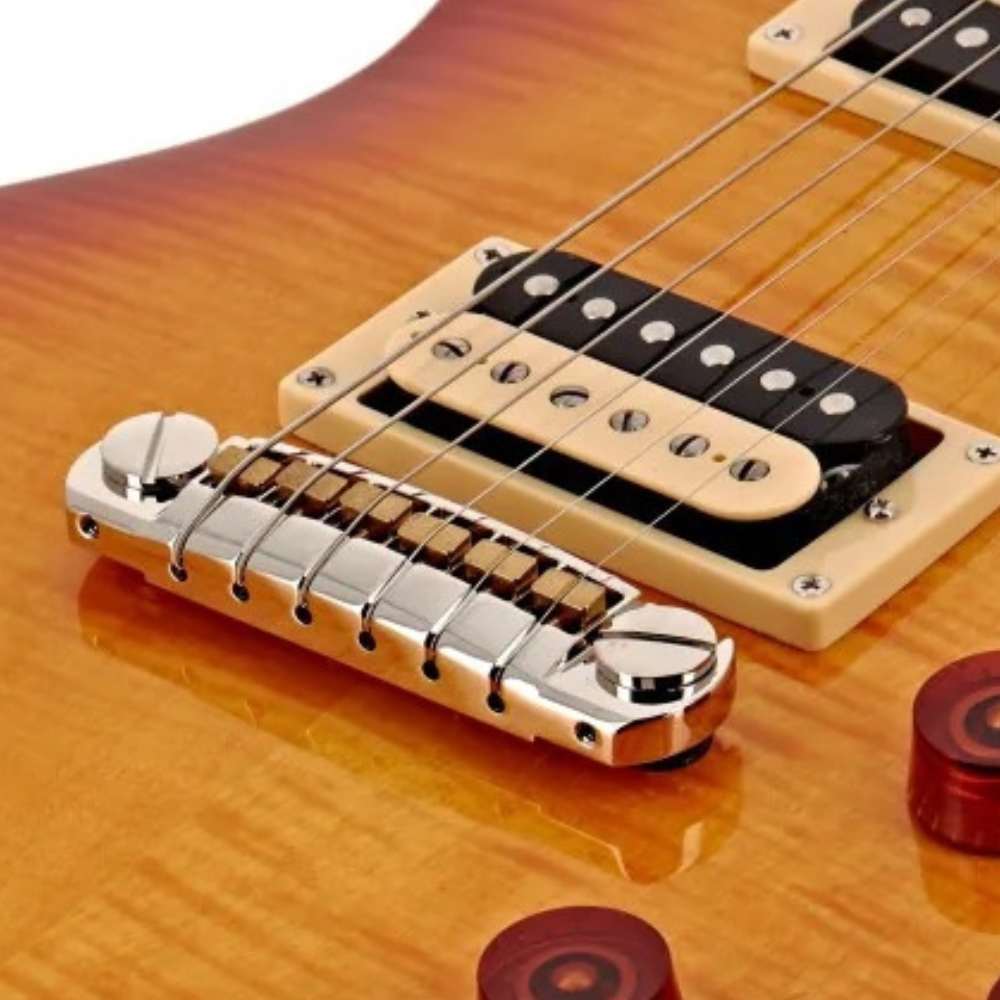
Comparison of Tune-O-Matic Bridge and Wraparound Bridge
As we’ve looked at both types of bridges have their pro’s and con’s. But let’s take a direct comparison between the two:
Sound
The difference in tone from bridges is slightly controversial. Some people are convinced there’s a huge difference in sound whereas others can’t notice anything.
But the general consensus is that the Wraparound has better sustain due to the way it is in contact with the body of the guitar. But don’t assume Tune-O-Matic bridges offer no or very little sustain. They’re still fine just maybe produce a bit less.
In terms of tone a wraparound bridge is quite punchy and can be aggressive sounding, usually slightly brighter and snappier when compared to Tune-o-Matic bridges. The Tune-O-Matic is a bit smoother, fuller and warmer.
Tuning Stability
Whilst there may be some slight differences in tuning stability it shouldn’t be a real issue. Tune-O-Matic bridges are generally a little more stable as the string break angle on a Wraparound bridge can sometimes make them unstable.
But it’s not all that common nor something guitarists complain about on a regular basis. Basically if you want a Wraparound bridge don’t let the tuning stability put you off.
Changing Strings
There’s not a huge difference in how difficult it is to change the strings on both bridges. Wraparound bridges are marginally easier as you can just thread the string through the bridge and, as the name implies, wrap it around. The fact that it’s a single unit means there’s less to fiddle with.
Tune-O-Matic bridges are still simple to restring but due to the two pieces that make up the bridge they are slightly more complicated. Realistically though it’s an easy job and the minor differences in restringing both bridges shouldn’t play a part in deciding which bridge you choose.
Setup and Use
Tune-O-Matic bridges require a littlre more more setup and adjustment as each saddle needs to be adjusted individually. However, once set up properly they are relatively easy to use and maintain.
Wraparound bridges though are simpler in design and require less setup. But as already mentioned they can be more difficult to adjust the intonation due to this simple design.
Playing Style
Some bridge types suit certain music genres and styles better than others. For example floating bridges are used heavily within metal because metal players like to use the tremolo arm to perform specific techniques.
But Wraparound and T-O-M bridges don’t differ enough or offer the ability to do techniques to mean one suits a genre more so than the other. You shouldn’t have any problems playing most styles of music on either.
Comfort
Comfort is very much a personal thing so keep that in mind. What one person finds comfortable another may not.
However some players find Tune-O-Matic bridges a bit less comfortable. The way they are constructed can make them dig in to your hand slightly and the two pieces less comfortable to rest your hand on. This is even more apparent when palm muting as the hand has to maintain contact with the bridge.
The fact that a Wraparound bridge is bigger and a single, smooth piece is the reason why players find them more comfortable. But as mentioned it’s a personal thing and best to try them out yourself to decide if you agree.
Price
Tune-o-Matic bridges are often found on higher end guitars (although not exclusively) and tend to be more expensive themselves. This is down to them having a more complex design and using more parts.
Wraparound’s on the other hand are generally more affordable.
Guitars That Use Tune-O-Matic Bridges
The most famous guitar that uses a Tune-O-Matic Bridge is the Gibson Les Paul. In fact most of the Gibson lineup have T-O-M bridges: the Standard, Studio, Custom, Classic, Tribute, Traditional etc. all feature them.
Gibson Explorer’s, Firebird’s, Flying V’s and SG’s also have T-O-M’s.
Some PRS’s come with Tune-O-Matic’s which isn’t a huge surprise as they’re very similar in design to Gibsons.
Guitars That Use Wraparound Bridges
Wraparound bridges are less common the Tune-O-Matic’s. The Gibson Les Paul Junior is probably the most famous guitar to use a Wraparound but also Gibson Melody Makers and Les Paul Specials have them too.
Some Epiphones also use them, the Epiphone Les Paul Junior the most obvious example. And PRS have quite a few models that come with Wraparound bridges.
Customizing
Modifying and customizing guitars is common. The bridge is one area you of many areas you can get creative.
Top Wrapping
If you have a wraparound bridge you can “top wrap” it. Top wrapping is when you pass the strings over the tailpiece and then wrap them under it rather than threading the strings through it. The strings pass through on the pickup side and thread back towards the bridge.
Some guitarists choose this because it changes the tone and sustain of the guitar. The idea behind top wrapping is that it increases sustain because more of the strings are in contact with the tailpiece and so greater vibrations can be transferred through to the body of the guitar then back to the strings.
You also end up with a much shallower angle that the strings break over the saddles. This makes the strings looser and “slinkier”, which allows you to bend them more easily.
Adding a Tremolo
Tune-O-Matic bridges do have the option to add a tremolo arm (whammy bar). It’s not an easy undertaking though and best left to professionals unless you really know what you’re doing!
Alternatively you can also get a few guitars that feature that combination of T-O-M bridge with tremolo. Gibson do a variation of the SG with a Vibrola tremolo.
I think it looks a bit odd but if that’s what you want then the option is there.
Which is Best?
Having played and owned guitars with both types of bridges my opinion is going to sound a bit noncommittal, but honestly, I really like them both.
I understand the frustrations with floating bridges because I share them – they can be great but are also a big hassle a lot of the time. But Tune-O-Matic’s and Wraparounds both do pretty good jobs without many drawbacks.
Of the guitars I currently own one has a hardtail (ashtray bridge on a Telecaster) and two have Tune-O-Matic’s. So that might look like I lean more in favor of the Tune-O-Matic. But I love Les Paul Juniors and their Wraparound bridge and am actively looking to get one.
So I don’t think there’s enough between the two to really come down that strongly on either side. Neither are perfect and they do have separate issues that might annoy you. But I personally don’t think they’re dealbreakers in the way a floating bridge can be.
Related Articles